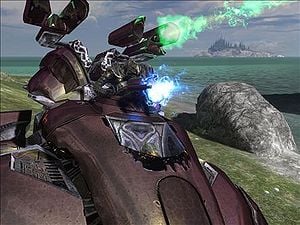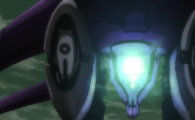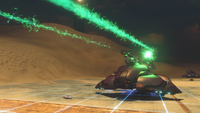Fuel rod cannon: Difference between revisions
From Halopedia, the Halo wiki
m (Text replacement - "==Related links==" to "==See also==") |
m (Text replacement - "<references/>" to "{{Ref/Sources}}") |
||
| Line 100: | Line 100: | ||
==Sources== | ==Sources== | ||
{{Ref/Sources}} | |||
==See also== | ==See also== | ||
Revision as of 21:51, April 14, 2021
| Fuel rod cannon | |
|---|---|

| |
| Production overview | |
|
Manufacturer: |
Assembly Forges (presumably[note 1]) |
|
Type: |
Anti-personnel/vehicular weapon |
| Specifications | |
|
Length: |
Varied |
|
Ammunition type: |
|
|
Low (1 shot per 7 seconds) to average (2 round per second) | |
|
72 metres per second (160 mph) | |
|
Effective range: |
Medium, 165 metres (540 ft) |
| Service history | |
|
In service: |
|
The fuel rod cannon is a Covenant vehicle-mounted projectile weapon.[2] It is a larger and more powerful version of the Type-33 fuel rod gun, with anti-vehicle and anti-air applications. It is employed by a variety of vehicles, including Type-26 Banshees, Anti-Air Wraiths and a variant of the Type-26 Shade.
Design details
The weapon fires fuel rods, caseless projectiles which contain radioactive, highly explosive material encased in a transparent shell. The colloquialism "fuel rod", commonly used by the UNSC to refer to the weapon's ammunition, is technically incorrect;[1] it originates from the projectiles' resemblance to how nuclear fuel rods are commonly depicted in popular culture.[3]
This weapon functions in a similar fashion to the man-portable Type-33 fuel rod gun, but the fuel rods fired by the cannon are larger and more damaging. Most fuel rod weapons, including the T-33, fire ammunition designated as Class-2, which is effective against armor and infantry on short ranges. For anti-air combat, however, the Covenant employ a more effective type of fuel rod, designated as Class-3. Although visually identical to the Class-2 rounds, Class-3 fuel rods are more powerful, have a greater range, and are capable of tracking the heat signatures of vehicles.[2]
Usage
Banshees are equipped with a single fuel rod cannon for attacking hardened ground targets, while Anti-Air Wraiths are fitted with two pods of three. Fuel rod Shades are equipped with a single fuel rod cannon. All of these variants fire Class-2 rounds, with Banshees also being capable of firing Class-3 projectiles.
The Mgalekgolo's assault cannon uses similar technology, as it fires bolts of green incendiary fluid.
Banshees often use the weapon to wipe out groups of infantry, or to soften heavily armored targets before finishing them with its medium plasma cannons. The projectiles are especially lethal to light vehicles, such as a Type-32 Ghost or M274 Mongoose, which will be sent flying by the explosion.
The automated turrets used to defend Covenant bases are sometimes equipped with fuel rod cannons, in order to better defend the base against vehicular assault.
Trivia
- In Halo 3, on Heroic or Legendary, if an Anti-Air Wraith gets a direct hit on the player, it will kill him/her instantly. However, it is rather rare for an Anti-Air Wraith to attack ground targets.
- In Halo 3 and Halo 3: ODST in a similar case to the fuel rod gun if an NPC is flying the vehicle and shoots the Banshee Bomb and it will have an even stronger lock-on, but yet again when the player attempts this it will lack said feature, however in Halo: Reach and Halo 5: Guardians it is possible for the player to use this feature.
- In Halo 2, Halo 3: ODST, Halo: Reach, and Halo 4 T-33 fuel rod guns are referred to as fuel rod cannons.
Gallery
The fuel rod variant of the T-26 ASG turret.[5]
A Banshee charging its fuel rod cannon in Halo: Legends's Prototype.
A Type-54 Banshee firing its fuel rod cannon at a Phaeton in Halo 5: Guardians.
A Type-52 Anti-Aircraft Wraith firing a barrage of Class-3 Fuel Rods.
List of appearances
Note
- ^ Given that the fuel rod canon-mounted vehicles and the Type-33 Light Anti-Armor Weapon are all manufactured in the Assembly Forges, it is safe to assume the fuel rod cannon originates from there as well.
Sources
- ^ a b Halo: The Essential Visual Guide, page 77
- ^ a b c Halo: The Essential Visual Guide, page 9
- ^ Bungie.net: Type-33 Light Anti-Armor Weapon
- ^ Halo: Landfall
- ^ Halo: Reach
See also
![An explosion from a Banshee's fuel rod cannon.[4]](https://halo.wiki.gallery/images/thumb/2/26/Fuel_rod_explosion.JPG/200px-Fuel_rod_explosion.JPG)
![The fuel rod variant of the T-26 ASG turret.[5]](https://halo.wiki.gallery/images/thumb/0/07/Shade_turret_4.jpg/200px-Shade_turret_4.jpg)


